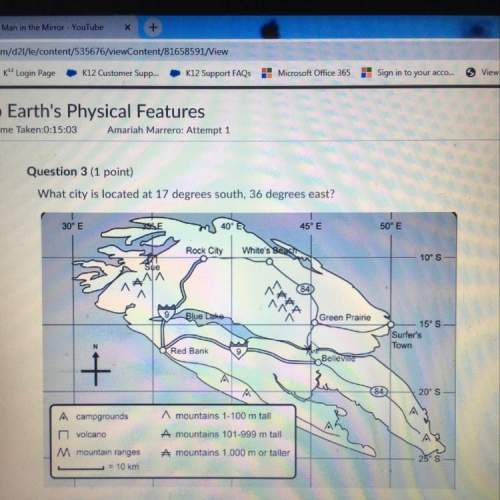
Chemistry, 01.07.2019 04:50, tmrsavage02p7cj16
An example of a pure substance in everyday life is select one: a. a cola drink b. concrete c. sugar d. pond water a soft drink is an example of a(n) select one: a. compound b. element c. heterogeneous mixture d. homogeneous mixture the best way to understand the submicroscopic world is with select one: a. powerful microscopes b. very accurate measuring devices c. models d. physical properties an example of a chemical formula is select one: a. na b. 4.5 g/ml c. d = 13.6 g/l d. h2so4 which of the following materials cannot be broken down into a simpler form? select one: a. solution b. element c. compound d. mixture how many atoms are present in one unit of sodium sulfate, na2so4? select one: a. 4 b. 7 c. 2 d. 1 which of the following is not an example of a model? select one: a. a floor lamp b. a wind tunnel c. a road map d. a globe matter that is large enough to be seen is select one: a. macroscopic b. massive c. submicroscopic d. a scientific model

Answers: 1
Other questions on the subject: Chemistry



Chemistry, 22.06.2019 14:10, cameronbeaugh
13. a covalent bond between two atoms is likely to be polar if: a. one of the atoms is much more electronegative than the other. b. the two atoms are equally electronegative. c. the two atoms are of the same element. d. the bond is part of a tetrahedrally shaped molecule. e. one atom is an anion.
Answers: 1

Chemistry, 22.06.2019 20:10, jakhunter354
The lattice enthalpy (formation of ionic solid from ions in the gas phase) for agcl(s) is -916 kj/mol and the hydration enthalpy (dissolution of gaseous ions into water) is -850 kj/mol. how much heat (in joules) is involved in forming 1l of saturated agcl solution (1.8 × 10-4 g / 100 ml water) by dissolving agcl(s)? assume solution volume does not change much upon dissolution. the equations are given below. ag+(g) + cl−(g) æ agcl(s)
Answers: 3
Do you know the correct answer?
An example of a pure substance in everyday life is select one: a. a cola drink b. concrete c. suga...
Questions in other subjects:




Mathematics, 05.12.2020 02:10


Mathematics, 05.12.2020 02:10



History, 05.12.2020 02:10







